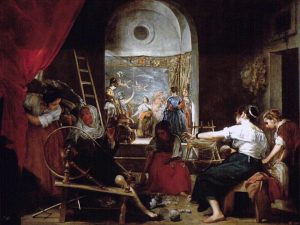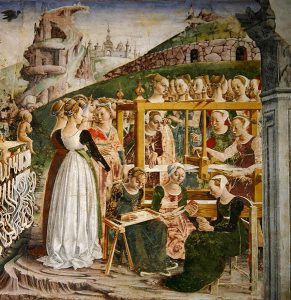31 Arachne in Ovid
BkVI:1-25 Arachne rejects Minerva
Tritonian Minerva had listened to every word, and approved of the Aonian Muses’s song, and their justified indignation. Then she said, to herself, ‘To give praise is not enough, let me be praised as well, and not allow my divine powers to be scorned without inflicting punishment.’ Her thoughts turned to Arachne, of Maeonia, whom she had heard would not give her due credit, in the art of spinning. The girl was not known for her place of birth, or family, but for her skill. Her father, Idmon of Colophon, dyed the absorbent wool purple, with Phocaean murex. Her mother was dead. She too had been of humble birth, and the father the same. Nevertheless, though she lived in a modest home, in little Hypaepa, Arachne had gained a name for artistry, throughout the cities of Lydia.
Often the nymphs of Mount Tmolus deserted their vine-covered slopes, and the nymphs of the River Pactolus deserted their waves, to examine her wonderful workmanship. It was not only a joy to see the finished cloths, but also to watch them made: so much beauty added to art. Whether at first she was winding the rough yarn into a new ball, or working the stuff with her fingers, teasing out the clouds of wool, repeatedly, drawing them into long equal threads, twirling the slender spindle with practised thumb, or embroidering with her needle, you could see she was taught by Pallas. Yet she denied it, and took offense at the idea of such a teacher. ‘Contend with me’ she said ‘I will not disagree at all if I am beaten’.

Bk VI:26-69 Pallas Minerva challenges Arachne
Pallas Minerva took the shape of an old woman: adding grey hair to her temples, and ageing her limbs, which she supported with a stick. Then she spoke, to the girl, as follows. ‘Not everything old age has is to be shunned: knowledge comes with advancing years. Do not reject my advice: seek great fame amongst mortals for your skill in weaving, but give way to the goddess, and ask her forgiveness, rash girl, with a humble voice: she will forgive if you will ask.’ Arachne looked fiercely at her and left the work she was on: scarcely restraining her hands, and with dark anger in her face. Pallas, disguised it is true, received this answer. ‘Weak-minded and worn out by tedious old age, you come here, and having lived too long destroys you. Let your daughter-in-law if you have one, let your daughter if you have one, listen to your voice. I have wisdom enough of my own. You think your advice is never heeded: that is my feeling too. Why does she not come herself? Why does she shirk this contest?
The goddess said ‘She is here!’ and, relinquishing the old woman’s form, revealed Pallas Minerva. The nymphs and the Phrygian women worshipped her godhead: the girl alone remained unafraid, yet she did blush, as the sky is accustomed to redden when Aurora first stirs, and, after a while, to whiten at the sun from the east. She is stubborn in her attempt, and rushes on to her fate, eager for a worthless prize. Now, Jupiter’s daughter does not refuse, and does not give warning, or delay the contest a moment. Immediately they both position themselves, in separate places, and stretch out the fine threads, for the warp, over twin frames. The frame is fastened to the cross-beam; the threads of the warp separated with the reed; the thread of the weft is inserted between, in the pointed shuttles that their fingers have readied; and, drawn through the warp, the threads of the weft are beaten into place, struck by the comb’s notched teeth. They each work quickly, and, with their clothes gathered in tight, under their breasts, apply skilful arms, their zeal not making it seem like work. There, shades of purple, dyed in Tyrian bronze vessels, are woven into the cloth, and also lighter colours, shading off gradually. The threads that touch seem the same, but the extremes are distant, as when, often, after a rainstorm, the expanse of the sky, struck by the sunlight, is stained by a rainbow in one vast arch, in which a thousand separate colours shine, but the eye itself still cannot see the transitions. There, are inserted lasting threads of gold, and an ancient tale is spun in the web.
Bk VI:70-102 Pallas weaves her web

Pallas Athene depicts the hill of Mars, and the court of the Aeropagus, in Cecrops’s Athens, and the old dispute between Neptune and herself, as to who had the right to the city and its name. There the twelve gods sit in great majesty, on their high thrones, with Jupiter in the middle. She weaves the gods with their familiar attributes. The image of Jupiter is a royal one. There she portrays the Ocean god, standing and striking the rough stone, with his long trident, and seawater flowing from the centre of the shattered rock, a token of his claim to the city. She gives herself a shield, a sharp pointed spear, and a helmet for her head, while the aegis protects her breast. She shows an olive-tree with pale trunk, thick with fruit, born from the earth at a blow from her spear, the gods marvelling: and Victory crowns the work.
Then she adds four scenes of contest in the four corners, each with miniature figures, in their own clear colours, so that her rival might learn, from the examples quoted, what prize she might expect, for her outrageous daring. One corner shows Thracian Mount Rhodope and Mount Haemus, now icy peaks, once mortal beings who ascribed the names of the highest gods to themselves. A second corner shows the miserable fate of the queen of the Pygmies: how Juno, having overcome her in a contest, ordered her to become a crane and make war on her own people. Also she pictures Antigone, whom Queen Juno turned into a bird for having dared to compete with Jupiter’s great consort: neither her father Laomedon, nor her city Ilium were of any use to her, but taking wing as a white stork she applauds herself with clattering beak. The only corner left shows Cinyras, bereaved: and he is seen weeping as he clasps the stone steps of the temple that were once his daughters’ limbs. Minerva surrounded the outer edges with the olive wreaths of peace (this was the last part) and so ended her work with emblems of her own tree.
Bk VI:103-128 Arachne weaves hers in reply
The Maeonian girl depicts Europa deceived by the form of the bull: you would have thought it a real bull and real waves. She is seen looking back to the shore she has left, and calling to her companions, displaying fear at the touch of the surging water, and drawing up her shrinking feet. Also Arachne showed Asterie, held by the eagle, struggling, and Leda lying beneath the swan’s wings. She added Jupiter who, hidden in the form of a satyr, filled Antiope, daughter of Nycteus with twin offspring; who, as Amphitryon, was charmed by you, Alcmena, of Tiryns; by Danaë, as a golden shower; by Aegina, daughter of Asopus, as a flame; by Mnemosyne, as a shepherd; by Proserpine, Ceres’s daughter, as a spotted snake.
She wove you, Neptune, also, changed to a fierce bull for Canace, Aeolus’s daughter. In Enipeus’s form you begot the Aloidae, and deceived Theophane as a ram. The golden-haired, gentlest, mother of the cornfields, knew you as a horse. The snake-haired mother of the winged horse, knew you as a winged bird. Melantho knew you as a dolphin. She gave all these their own aspects, and the aspects of the place. Here is Phoebus like a countryman, and she shows him now with the wings of a hawk, and now in a lion’s skin, and how as a shepherd he tricked Isse, Macareus’s daughter. She showed how Bacchus ensnared Erigone with delusive grapes, and how Saturn as the double of a horse begot Chiron. The outer edge of the web, surrounded by a narrow border, had flowers interwoven with entangled ivy.
Bk VI:129-145 Arachne is turned into a spider
Neither Pallas nor Envy itself could fault that work. The golden-haired warrior goddess was grieved by its success, and tore the tapestry, embroidered with the gods’ crimes, and as she held her shuttle made of boxwood from Mount Cytorus, she struck Idmonian Arachne, three or four times, on the forehead. The unfortunate girl could not bear it, and courageously slipped a noose

around her neck: Pallas, in pity, lifted her, as she hung there, and said these words, ‘Live on then, and yet hang, condemned one, but, lest you are careless in future, this same condition is declared, in punishment, against your descendants, to the last generation!’ Departing after saying this, she sprinkled her with the juice of Hecate’s herb, and immediately at the touch of this dark poison, Arachne’s hair fell out. With it went her nose and ears, her head shrank to the smallest size, and her whole body became tiny. Her slender fingers stuck to her sides as legs, the rest is belly, from which she still spins a thread, and, as a spider, weaves her ancient web.
Source: Ovid’s Metamorphoses, translated by Anthony S. Kline (https://ovid.lib.virginia.edu/trans/Metamorph.htm)